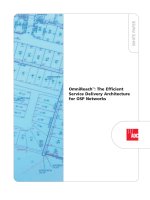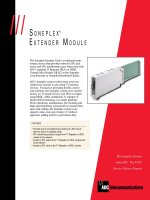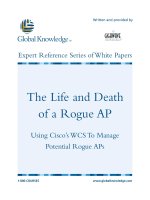Tài liệu Service Delivery Architecture pdf
Bạn đang xem bản rút gọn của tài liệu. Xem và tải ngay bản đầy đủ của tài liệu tại đây (434.38 KB, 8 trang )
WHITE PAPER
Service Delivery Architecture
for OSP Networks
Service Delivery Architecture for
OSP Networks
Carriers are faced with several critical decisions regarding upgrading their networks
from traditional circuit-switched services to supporting the increasing array of
broadband services customers are demanding today. The ability to deliver a
combination of voice, video, and data services will require many modifications to
existing infrastructures, challenging every service provider to seek ways to make this
migration to broadband as painless as possible in terms of cost, time, and ensuring
a future-proof network.
There are both challenges and trade-offs in upgrading existing voice networks to
support broadband services. Most importantly, each carrier must decide how far
to drive fiber into the network and what, if any, portion of the existing copper
plant can still be used. ADC offers solutions that will allow for any business model,
whether taking fiber to a node (FTTN) or directly to the customer premises (FTTP).
Depending on the carrier’s business model, it may not make the best sense to take
fiber all the way to the customer, particularly in brownfield build-outs. This makes
FTTN an attractive solution for getting broadband services to customers quickly
and cost effectively, while still providing a smooth migration path to FTTP when it
becomes necessary.
This paper will provide an overview of considerations and decisions involved in
upgrading legacy voice networks to broadband services. It will discuss the current
attributes and limitations of today’s copper technologies and how they will affect
broadband service delivery. It will also provide an overview of the resectionalization
process necessary to create smaller serving areas that support the higher bandwidth
broadband services require.
Broadband upgrade considerations
While the vast majority of greenfield broadband deployments can take fiber directly
to the customer premises at costs that are comparable to copper, this may not be
the optimal approach in all business models. The cost of trenching or boring fiber
routes, as well as digging up the property of existing customers, makes the ability
to use existing copper plants with new copper technologies a more attractive
solution.
With that in mind, carriers need to understand the range limitations of broadband
copper technologies, such as ADSL2+ and VDSL2. Although the reach could be
Service Delivery Architecture for OSP Networks
Page 3
as low as 2500 feet or as high as 5000 feet, most carriers
today are designing to 3000 feet to prevent the need of
continual changes to the infrastructure. Of course, each
deployment is unique and must be considered in terms of
geography, outside plant design, and up-front costs.
With the ever-increasing demand for more bandwidth,
specifically with emerging new video services, carriers must
realize that the deployment of more fiber will be necessary
in the future. Thus, the ability to smoothly migrate from
FTTN to FTTP must be considered as the new broadband
network deployment takes shape.
Resectionalizing the network for
broadband
Due to the range limitations of deploying broadband
services over existing copper infrastructure, the existing
voice distribution areas (DAs) will require resectionalization.
Large distribution areas that delivered voice services to
customers tens of thousands of feet from a central
office (CO) will now have to be designed with many
smaller sub-areas that have a range limit of 3000 feet.
Resectionalization of any distribution area also creates
additional considerations, such as the cost of service
delivery and truck rolls that may depend on the size and
quantity of the newly-resectionalized areas.
As the network is resectionalized, considerations for
the type of service delivery method can be extremely
important decisions. For example, how many different
delivery scenarios will be required throughout the network,
and does the solution have a consistent pattern across
the network for service technicians performing the work?
From the CO to the crossbox or remote terminal, the same
deployment strategy makes it easier for technicians to work
in any section of the network, thus reducing personnel and
training costs.
A typical CO distribution area is shown in Figure 1. It’s not
uncommon for the legacy switched networks to serve areas
beyond 18,000 feet. However, deploying copper-based
broadband services limits the range to about 3000 feet.
Customers residing more than 3000 feet from the CO may
not receive enough bandwidth for the services requested.
This figure shows how to resectionalize a large DA into
smaller serving areas to deliver broadband services.
3-5Kft
Pocket > 5Kft
Pocket > 5Kft
3-5Kft
3-5Kft
3-5Kft
Central Office Home DA
Re-Sectionalized
Central Office Home DA
Re-Sectionalized
Comp BB DSLAM
Cabinet with
Central Office
Customer Building
DLC Remote Cabinet
MX Host Cabinet
Crossbox
Crossbox
ONU
ONU
ONU
Crossbox
DLC (RT) DA
Re-Sectionalized
Figure 1: Resectionalizing the Distribution Area
Service Delivery Architecture for OSP Networks
Page 4
Depending on the size and density of the distribution area,
the resectionalization approach and quantity of smaller
serving areas may vary. The number of remote terminal (RT)
cabinets; the number of cross boxes; and the existence of
mini huts, controlled environment vaults (CEVs), or multiple
dwelling units (MDUs) within the original DA will help
determine the correct strategy. Other considerations are
also important – What is the density of subscribers within
the DA? Can one focus on a certain area where most of the
potential broadband customers reside? How much fiber
cable already exists in existing DA?
For simplicity, we will look at an existing DA that originally
was fed beyond 12,000 feet from a CO over copper
infrastructure. We will focus on three primary areas
that would encompass most typical resectionalization
processes.
The first area is the CO sub-distribution area. The new
CO home DA serves existing customers on copper within
3000 feet of the CO. The second area is called the remote
terminal (RT) digital loop carrier (DLC) sub-distribution area.
This area would use DLCs to support customers beyond the
CO reach, but within 3000 feet of the RT.
Finally, the low density areas, or “what’s left” after
resectionalizing the DA. In most cases, there will be
distribution cable remaining that has customers being
served, even as cables taper as you move deeper into
the distribution area. This scenario could exist where a
neighborhood was expanded on either side of its original
planned area. Typically, new equipment must be added to
reach these customers since the only existing infrastructure
is the cable itself
Each of these typical resectionalization processes has its
own attributes and challenges for the carrier.
CO Home DA
With a CO Home DA, all customers are fed by copper
directly from the CO. The DSLAM is located within the
CO and services are activated through a main distribution
frame (MDF) jumper – removing and rerouting jumpers
as required. Although this would seem to be fairly
straightforward with plenty of space and bandwidth from
the CO, there are some challenges involved within this
DA.
The DSLAM in the CO may require upgrading to support
the new broadband technology, typically ADSL2+ or VDSL
to VDSL2. Even though DSLAMs are typically less than 10
years old, the new ADSL2+ and VDSL2 technologies used
for the triple play are not always spectrally compatible with
original DSL flavors.
DLC (RT) DA
The next resectionalization area we will look at is the DLC
(RT) DA. In the 1980s, carriers deployed DLCs as a means
of multiplexing T1s to enable 24 plain old telephone service
(POTS) lines from just four copper wires. The copper was
taken from the CO to a DLC where it was multiplexed at a
12:1 ratio. Copper was also replaced with fiber to achieve
very large numbers of POTS channels out to the customer
base. This was a very lucrative means of stretching the
network to reach more customers, sometime as far as
15,000 feet from the DLC remote terminal, thus increasing
revenues for telephone service providers.
However, this poses a problem with upgrading to broadband
network capabilities that can only reach 3000 feet over the
same copper infrastructure. Many of these embedded
DLC and remote terminal distribution areas must now be
resectionalized into smaller 3000-foot sections. Current
network configurations cannot be used without stranding
a large percentage of customers. Carriers are left with
the choice of either handing stranded customers over to
competitors or finding a way to re-engineer the network
to service every customer.
Thus, the DA must be resectionalized to meet the 3000-
foot loop length requirement for broadband services.
Again, existing DSLAMs may also require upgrading to
co-exist with new broadband copper technologies, such as
ADSL2+ and VDSL2. The existing DSLAM service delivery
method, typically direct terminated into the cross box,
may not have enough binding posts to terminate the new
DSLAM. This creates a significant problem where space
may be limited in existing cabinets.
Pair bonding is another challenge; the method of
electronically connecting two copper outputs from the
DSLAM to essentially double available bandwidth requires
two individual pairs. For example, with a 12 Mbits/sec circuit
out of the DSLAM, pair bonding would produce a capability
of 24 Mbits/sec. However, even though pair bonding may
be supported by the terminal and/or crossbox, there are
other places within the network where cables taper down
to the point where access to additional copper pairs is
non-existent. Also, pair bonding is usually a trade-off. For
example, bonding every customer from a particular DSLAM
that supports 192 circuits, for instance, would only leave
capability to actually support 96 customers.
Many of the remote terminals lack the space to support a
DSLAM without adding another cabinet. Therefore, if there
is no room in the existing remote terminal cabinet, a new
broadband cabinet must be deployed, resulting in multiple
cabinets at some locations.
Another consideration is the thermal temperatures within
the remote terminal cabinet – adding any extra heat-
generating devices could create problems, even if the space
is available. In essence, the real challenge is to get the
DSLAMs deeper into the network without creating cabinet
“farms.”
Service Delivery Architecture for OSP Networks
Page 5
Low density areas
Once the distribution area is resectionalized several times,
there will likely be several low density areas remaining.
These are pockets of customer that are typically far from
the CO or RT cabinet. Since carriers do not wish to turn
these customers over to competitors or deny service, they
must consider how to economically provide the same
broadband services offered to other customers.
The same model for the DLC will probably not make
economic sense. Rather, new and possibly smaller remote
terminals and DSLAMs may have to be installed to
reach these outlying customers. This may even require
deploying new fiber from the CO in areas where fiber is
not available.
Pair counts may not be available for bonded DSL strategies
– a typical problem in low density areas. There simply is not
enough copper distribution plant to achieve pair bonding.
In this scenario, it’s very common to have only a 25-pair
cable serving at capacity. That leaves no room for pair
bonding and could even require additional copper facilities.
An economic solution may be necessary for deploying new
power and fiber requirements. By placing these smaller
and, in some cases, hardened DSLAMs very deep into
the network, optimum bandwidth can likely be achieved
without the need for pair bonding. This helps the cable
taper issue.
The solutions
ADC has developed service delivery solutions that
address the challenges associated with upgrading and
building out traditional circuit-switch networks to support
today’s broadband requirements. These solutions focus
on consistent, reliable, high-performance service delivery
approaches that achieve the same “look and feel” in all
areas of the network. ADC solutions meet the needs of
service providers to achieve faster time to market, future-
proofing, streamlined service delivery, lower up-front and
operational costs, simpler training for field forces, scalable
in size and an easy migration path to FTTP.
While service providers decide on the most cost effective,
reliable method delivering today’s voice, video and data
services to customers, they must investigate the pros and
cons of both FTTP and FTTN solutions to determine how far
to push the fiber. Cost parity between copper and fiber has
made FTTP the choice for Greenfield scenarios.
However, overbuilding existing networks with pure fiber
may be cost-prohibitive for many providers, making FTTN
an attractive alternative – particularly if it provides a
smooth migration to FTTP in the future. Whatever the
choice, ADC offers service delivery solutions that support a
consistent approach and provide carriers with an efficient,
cost effective, and future-proofed broadband network.
Service Delivery Architecture for OSP Networks
Page 6
Service Delivery Architecture for OSP Networks
Page 7
WHITE PAPER
Web Site: www.adc.com
From North America, Call Toll Free: 1-800-366-3891 • Outside of North America: +1-952-938-8080
Fax: +1-952-917-3237 • For a listing of ADC’s global sales office locations, please refer to our web site.
ADC Telecommunications, Inc., P.O. Box 1101, Minneapolis, Minnesota USA 55440-1101
Specifications published here are current as of the date of publication of this document. Because we are continuously
improving our products, ADC reserves the right to change specifications without prior notice. At any time, you may
verify product specifications by contacting our headquarters office in Minneapolis. ADC Telecommunications, Inc.
views its patent portfolio as an important corporate asset and vigorously enforces its patents. Products orfeatures
contained herein may be covered by one or more U.S. or foreign patents. An Equal Opportunity Employer
104616AE 3/07 Original © 2007 ADC Telecommunications, Inc. All Rights Reserved









